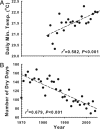Amphibian and reptile declines over 35 years at La Selva, Costa Rica
- PMID: 17449638
- PMCID: PMC1895953
- DOI: 10.1073/pnas.0611256104
Amphibian and reptile declines over 35 years at La Selva, Costa Rica
Abstract
Amphibians stand at the forefront of a global biodiversity crisis. More than one-third of amphibian species are globally threatened, and over 120 species have likely suffered global extinction since 1980. Most alarmingly, many rapid declines and extinctions are occurring in pristine sites lacking obvious adverse effects of human activities. The causes of these "enigmatic" declines remain highly contested. Still, lack of long-term data on amphibian populations severely limits our understanding of the distribution of amphibian declines, and therefore the ultimate causes of these declines. Here, we identify a systematic community-wide decline in populations of terrestrial amphibians at La Selva Biological Station, a protected old-growth lowland rainforest in lower Central America. We use data collected over 35 years to show that population density of all species of terrestrial amphibians has declined by approximately 75% since 1970, and we show identical trends for all species of common reptiles. The trends we identify are neither consistent with recent emergence of chytridiomycosis nor the climate-linked epidemic hypothesis, two leading putative causes of enigmatic amphibian declines. Instead, our data suggest that declines are due to climate-driven reductions in the quantity of standing leaf litter, a critical microhabitat for amphibians and reptiles in this assemblage. Our results raise further concerns about the global persistence of amphibian populations by identifying widespread declines in species and habitats that are not currently recognized as susceptible to such risks.
Conflict of interest statement
The authors declare no conflict of interest.
Figures


Comment in
-
Climate change implicated in amphibian and lizard declines.Proc Natl Acad Sci U S A. 2007 May 15;104(20):8201-2. doi: 10.1073/pnas.0702506104. Epub 2007 May 8. Proc Natl Acad Sci U S A. 2007. PMID: 17488825 Free PMC article. No abstract available.
References
-
- Stuart SN, Chanson JS, Cox NA, Young BE, Rodrigues ASL, Fischman DL, Waller RW. Science. 2004;306:1783–1786. - PubMed
-
- Mendelson JR, Lips KR, Gagliardo RW, Rabb GB, Collins JP, Diffendorfer JE, Daszak P, Ibanez R, Zippel KC, Lawson DP, et al. Science. 2006;313:48. - PubMed
-
- Pounds JA, Bustamante MR, Coloma LA, Consuegra JA, Fogden MPL, Foster PN, La Marca E, Masters K, Merino-Viteri A, Puschendorf R, et al. Nature. 2006;439:161–167. - PubMed
-
- Collins JP, Storfer A. Divers Distrib. 2003;9:89–109.
MeSH terms
LinkOut - more resources
Full Text Sources

